Shaping Vancouver 2018: Conversation 3
Change in Living Communities – Mount Pleasant and the SkyTrain
In this session of Shaping Vancouver, we focus on the recently-announced SkyTrain extension that will include a new station in the core of Mount Pleasant. This has provoked some fears that rising property taxes and increasing rent & maintenance costs will squeeze out “the hip, little village”, as well as drive dramatic new developments. With such a major infrastructure project on the horizon in Mount Pleasant–similar to previous transformations of the Cambie Corridor―the City will have to determine how the qualities definitive of Mount Pleasant can be protected and/or adapted due to this comprehensive land use change. In this session, the panelists discussed a number of social priorities, including housing affordability, neighbourhood integration, the strength of the Corridor’s job market, and the unique cultural fabric of Mount Pleasant.
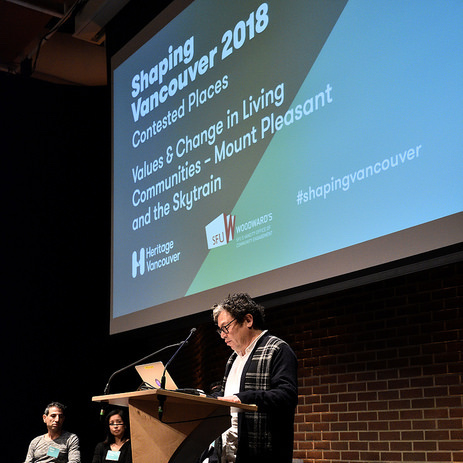
Moderator
Bill Yuen:
- Executive Director of the Heritage Vancouver Society
Panelists
Alyssa Myshok: Mount Pleasant resident, participant in Mount Pleasant Community Plan, lifelong transit user
Tamim Raad: Principal of Access Planning Consultants, former Director of Strategic Planning and Policy at TransLink
Sarah Savoy: Owner, Much & Little
Michael Wiebe: Owner, Eight 1/2 Restaurant, past President of the Mount Pleasant BIA, Vancouver City Councillor
The recently-announced SkyTrain extension will cut directly through the Mount Pleasant neighbourhood, which stretches from Cambie Street to Clark Drive along the Broadway Corridor. The junction where Main Street and Kingsway converge is the historic and cultural heart of this area, lined with pedestrian-friendly streets, independent stores and cafes, and a village atmosphere courtesy of affordable rental apartments, historic architecture, and independent businesses.
Planners, developers, and policymakers in Vancouver have spent decades debating the improvement of the rapid transit network along the Broadway Corridor. As the City starts the planning process, it has an opportunity to address a number of different social priorities, including housing affordability, neighbourhood integration, the strength of the Corridor’s job market, and the unique cultural fabric of Mount Pleasant.
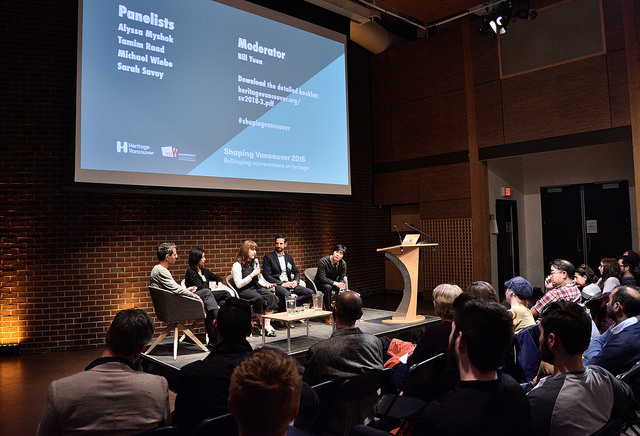
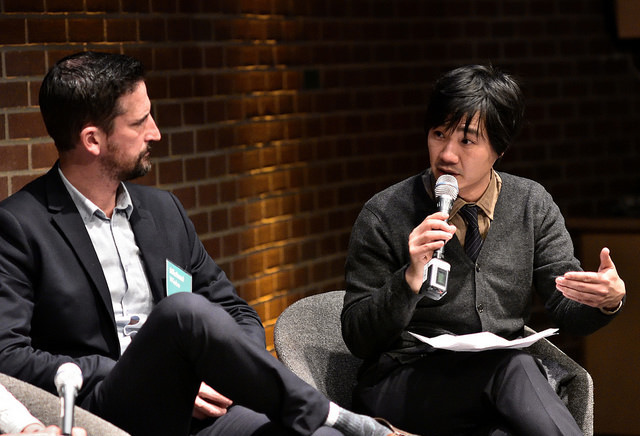
How does “heritage” apply to Mount Pleasant? (1:40)
Moderator Bill Yuen opened the discussion by explaining that heritage seeks to understand what is of value to people. This includes a wide range of values, and is not only concerned with old buildings, but links spatial issues with social issues and lived experiences. This way of thinkings allows us to be aware of the secondary effects that are incurred when we make interventions into our environment. With regards to the upcoming city-wide plan, Bill Yuen believes that rather than focusing on just the constituent parts of a neighbourhood, we should instead focus on the relationships that people have with those parts within that environment.
In this discussion we focus on Mount Pleasant in relation to the Broadway Plan, which was approved by City Council earlier in the year. According to John Grottenberg of the City of Vancouver’s Broadway Corridor Planning Team, the intent of the Broadway Plan is to coordinate a comprehensive plan for the Broadway area through the delivery of new rapid transit within the framework of a plan with land use, job space, affordable housing, park and public space, art, culture, heritage, and public amenities. With the adoption of the ‘Terms of Reference Document‘ rezoning will generally not be considered in Mount Pleasant until the two-year planning process is seen through.
At Heritage Vancouver we believe in the importance of the public sphere, and as such we believe that it is valuable to expose everyone participating in the decision-making process to a diversity of perspectives to help them make judgements while planning our city. To those participating in the upcoming planning process, we hope that this talk gives you something to think about regarding heritage.
Questions to the panelists
What brought you to Mount Pleasant? (13:39)
Sarah Savoy moved to Mount Pleasant to open her business, Much & Little, after a long research and planning process. She believed that Mount Pleasant was the right neighbourhood for her because of its particular identity. She describes it as an “energy of creativity” and as “a neighbourhood with a soul” that she wanted to be a part of. Tamim Raad jumped in and said that Main Street has an incredible diversity of people and businesses within walking distance that is hard to find, and the reason that he moved into the neighbourhood in 1995. To him, Mount Pleasant represents a “confluence” of all of Vancouver.

What are some of the concerns around developers thinking that Mount Pleasant is becoming a development opportunity? (17:30)
Councillor Micheal Wiebe explained that “What we liked about Mount Pleasant was that feeling that it was a complete community, and we feel that that is a little threatened now.” He went on to say that there is a feeling among small business owners that they do not have long-term security. People are not as able to reinvest in their business because they feel nervous about their longevity. While there have been scares in the past of dramatic changes to the neighbourhood, people are now especially nervous that development could take away the unique feeling that everybody loves about Mount Pleasant. Will the new developments come with a Tim Hortons, or will Mount Pleasant still host the beloved independent shops that have great history? People are asking themselves if they want to fight to stay in the neighbourhood if the costs are rising and the character that they love is being lost.
As a business owner, do you think that development could be good for you if it brings in more traffic? (23:20)
Sarah Savoy responded by explaining that “it’s hard to talk about this without talking about affordability.” A year ago, her rents rose 80% but she truly wanted to stay in the neighbourhood, and so recently had to move her shop to a new location where she only has half the space. Sarah went on the say that “gentrification is not necessarily a bad thing, but a certain degree of change is inevitable. She went on to explain, “When I moved in in the 2000s, I was part of a wave of gentrification at the time.” But at this point, she says that there is definitely a sense of unease in the neighbourhood and everyone has a possible exit plan.
Tamim Raad added to this saying that no one really expects Main Street to the static because it is always changing and it is an incredibly local street, where business owners live in the neighbourhood (26:50). As change comes, it is worth maintaining that local character of the neighbourhood. “Gentrification towards banality and sameness is what scares me,” Sarah said. She then elaborated this intangible heritage of the neighbourhood is what needs to be considered. It’s the local businesses of the area and its walkability that are integral to the sense of community. In Sarah Savoy’s view, “everyone has a plan B, everyone is thinking in chunks of three or four years, rather than in ten-year terms. Everyone is now thinking of an exit strategy.”
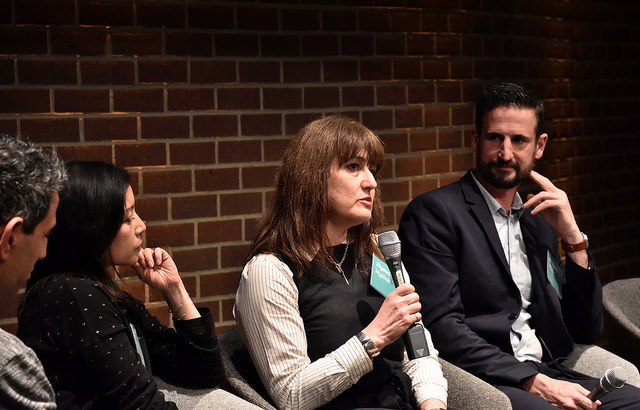
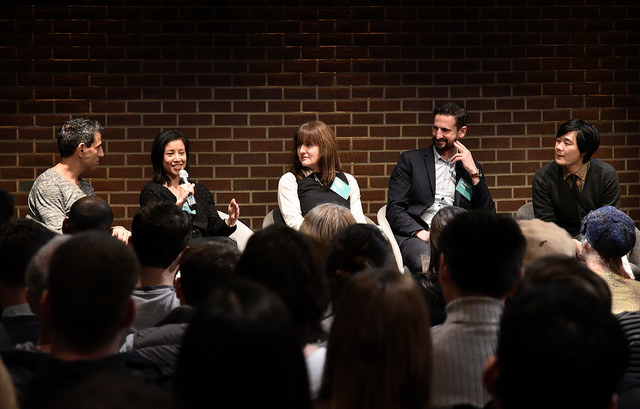
What do you see as a good balance for density in Mount Pleasant? (29:43)
Councillor Wiebe reflected on his time with the Mount Pleasant Implementation Plan, where a number of community members met to decide where they as a community felt that their neighbourhood could densify. At their meetings, they singled out three locations where they thought they could put in high rises without disturbing the character of the neighbourhood. This plan, according to the Councillor, was incredible because it showed a community coming together to propose positive changes and developments that worked with Mount Pleasant’s identity. However, the plan was shut down and in the overall view of the participants from the community, the consultation didn’t matter because they weren’t heard after they had put so much effort in.
Alyssa Myshok then questioned the approach that is often taken to development (33:25). “What if we flipped this approach. We should keep our Main Street at human scale, let’s keep the walkability, let’s keep the appeal. What happens if we go in to these single-family [neighbourhoods] and rethink the zoning. We keep building on the same plan and ideas that are as old as the city, maybe we need to rethink where we are as a society and rewrite our approach completely.” In response, Tamim Raad said that as far as planning is concerned, we continue to build on a site by site basis but up until now any comprehensive vision from the city was absent, and there was no overarching vision that could be applied to a site- or corridor-scale. Adding on, Councillor Wiebe brought this back to his work with the Mount Pleasant Plan, where people began to recognize that there are give and takes, but they can keep the character that they want.
Adding on, Sarah Savoy then explained that “As a shopowner, of course I want density and increased traffic in my neighbourhood, but the form of the density is of concern to me. It doesn’t have to be in a few big chunks, it could be more well dispersed to create a walking neighbourhood.” (35:00)
Should potential density be more dispersed through the city rather than along various corridors? (36:40)
Tamim Raad spoke to two different pressures that got in the way of dispersed densification. First, there is strong pressure on developers to maximize profit, by putting in as much density as possible. Second, the City faces pressure to put in as much density as possible to reduce automobile dependence and hopefully drive down housing costs. However, densification is often met with community resistance, which is why the City chooses to densify only where it is easiest, such as along jobs corridors. In European cities, density is often more evenly distributed, with many cities there being more dense than Vancouver but do not have the wild disparity in density between neighbourhoods that Vancouver does. This shows that density can take a number of different forms, and while European cities grew with even density organically over a longer time, it does show that there are a number of options in between single-family homes and high-rise towers. Rather than thinking about spreading out the impact of density, Tamim Raad believes that we should think about spreading out the benefits of density.
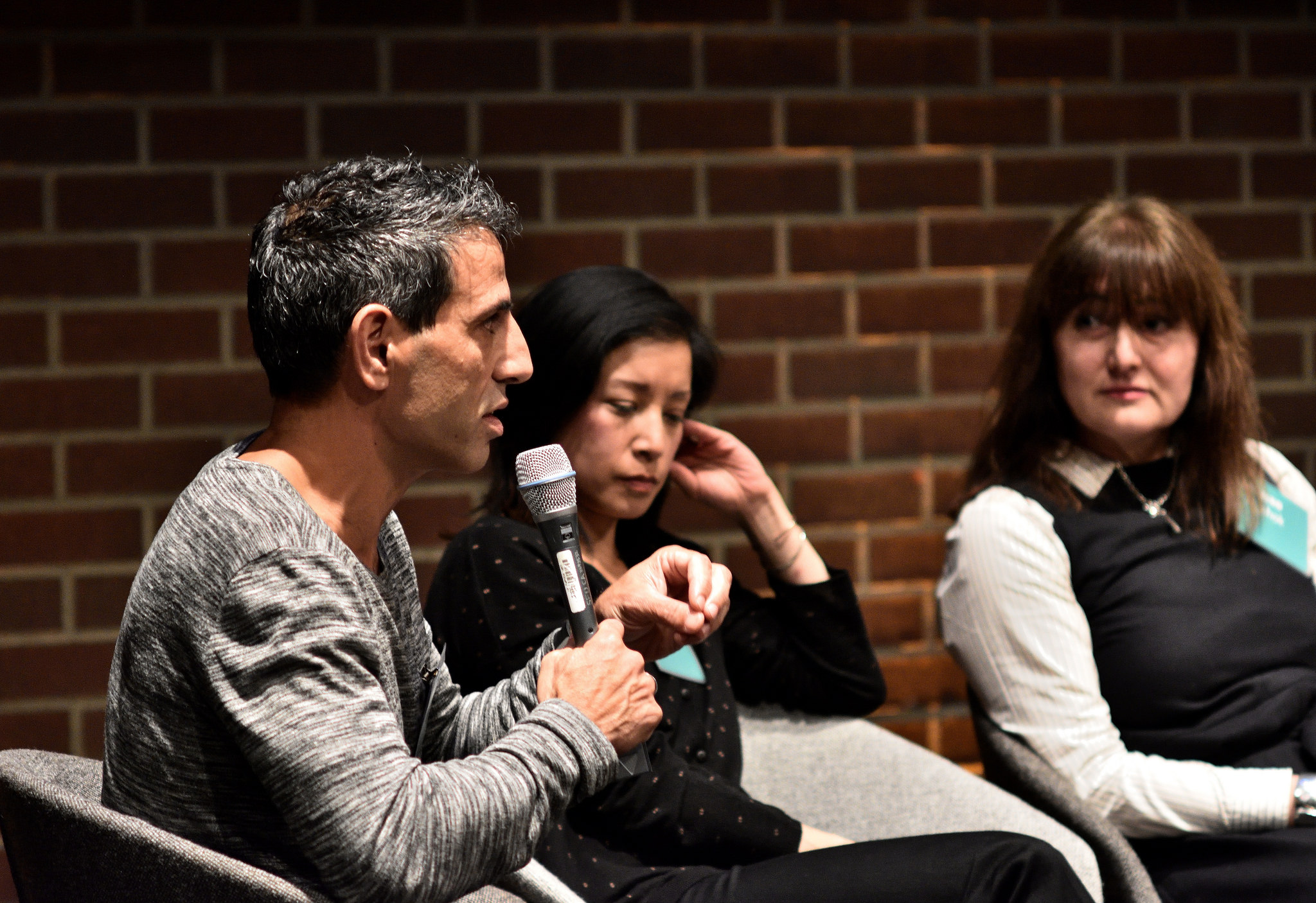
How do we talk to people in single-family neighbourhoods about introducing density in their neighbourhoods? (43:12)
Tamim Raad responded by saying that we must be aware of the particular needs of the communities in question. He spoke about the Turner’s Dairy development application at 17th and Ontario that was greeted very negatively by the community because the City did not effectively consult with the residents, who had concerns over parking and traffic. Tamim Raad believes that they might have met less resistance if they had addressed the biggest issues head-on. Similarly, approving density will always be difficult if it is done in a piecemeal fashion, but could become easier if all development in the city was working towards a common city-wide vision.
Going on, Tamim Raad spoke about how people often fear change but then get used to it when it occurs. This requires an ongoing dialogue, where neighbourhoods can increase density a certain amount, and then people see that when done smartly there is no harm to the neighbourhood character. We have already seen this happen with basement suites and laneway houses, and we are now at a tipping point where we can have a bigger discussion about introducing increased density into low-density neighbourhoods.
Alyssa Myshok then added (46:21) that “we are sitting in a place that might not be here if people didn’t push back,” referring to the Woodwards building. “The people who push back are not pushing back on density, but they want smart densification. The two aren’t incompatible.” Continuing, she said that “if we had the bravery to engage communities then we can start to get through to them.
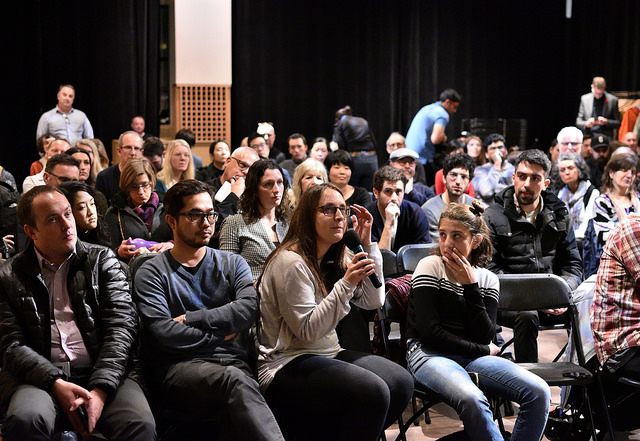
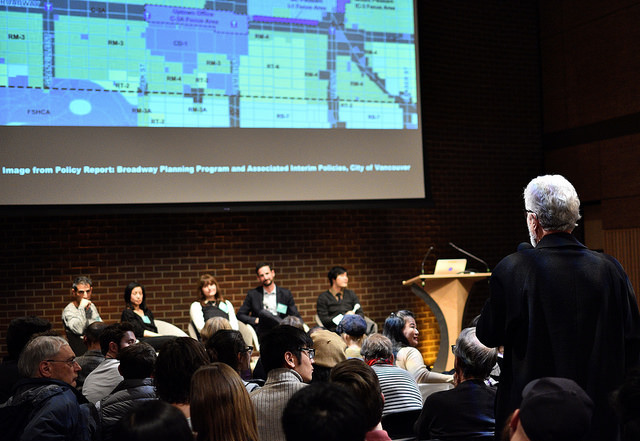
Questions from the audience
Through hearing all these stories, I see that many people came to see a way forward with new developments. Do you feel that more community engagement would help this kind of planning?
Tamim Raad responded by saying that “Bureaucrats are afraid of big processes because they are afraid of potential outcomes. The bigger that processes get, the scarier they become. But they also become more rewarding and so that could be the next big, brave step for the City to take. If the City had an overarching vision to build to, it would be more effective than fighting to get each project through on a site-by-site basis.”
Adding on, Sarah Savoy said “There is a lot of community engagement in Vancouver–I think that the issue is the broken trust between what the community put forward and then what they said being put aside. What we need is specifics, because current City plans are subject to a lot of interpretations.”
Councillor Wiebe said “If we want to deliver good plans, we need to make sure that the community benefits come early. People want to see that you’re going to step up to your part of the deal.
It seems that no one is talking about the elephant in the room–the Broadway subway. Once the subway comes in, everything that we've been talking about will be completely changed, and the type of transit that we choose will determine the built form of the entire city. Would you support an above-ground LRT system across the city?
Councillor Wiebe spoke first, responding that “At the Mayors’ council, we learned that Surrey will not be going with LRT. With the federal election coming up, it does look like the subway line will eventually go all the way out to UBC. It’s not a done deal but that’s the talk right now. When the Broadway plan first showed up, [there was immediate concern that density would negatively impact the neighbourhood character] and the Mount Pleasant BIA joined up with all the other BIAs and hired a lawyer to ensure that what happened to the Cambie Village wouldn’t happen again. Currently–and I know that you’re shaking your head–we plan to take a look when the plan comes up for review, but we are planning for the subway extension. We have to do everything in our power to protect our urban villages and make sure that transportation planning is done right.”
Alyssa Myshok also joined in, “As a lifelong transit user, this is clearly a very difficult question. Why do we need this subway? It’s not going to build the [kinds of] streets that we want. On the other hand, we want to look at where Vancouver is going 50 or 100 years down the line. In Europe, subways have been built in a way that maintains the walkable street life. We need to recognize that we are putting in a subway in a city that has established itself as a place that has soul. It’s a huge discussion – a subway offers efficiency that no other transit can, but maybe it can be a piece of a larger solution that also involves ground transit.”
The form of Main Street is derived from the fact that it's an old streetcar suburb. Do you feel that this is an opportunity for innovation when these developments come through? Can we start to put commercial activity on residential streets?
Sarah Savoy remarked “I love that idea, of letting commercial activity bleed onto non-arterial streets. For me personally though, I rely on foot traffic. When I had to move my business, I realized that moving two blocks in certain directions would make a huge difference. It’s a hard question to answer. I love the idea of expanding to the side streets, but it takes time for people to realize this. And as a small business owner, it can be hard to be that pioneer.”
Tamim Raad added on, “The best thing we could do to help small business owners on Main Street would be to narrow it. Main Street’s width changes across space, going from an 86-foot right of way to a 100-foot right-of-way. If we made it easier to walk along the street, it would drive up foot traffic.”
Councillor Wiebe also added “One of the things that we’re looking at in Mount Pleasant is a co-op on the Heritage Triangle to save the small business[es] there, and maybe also have some space open for artists’ studios.” Continuing, the Councillor remarked that at an Urbanarium, City Council looked at some really creative mixed-use spaces from Strathcona, but a lot of the cool, eclectic spaces that people love wouldn’t be approved if they were proposed right now. That’s because they’re having trouble with the permitting.
I moved to Mount Pleasant in the early 90s, and it was very different then. The Mount Pleasant heritage that you're worried about is only from the past few years. I support the Broadway line.
From the audience, Neil Wyles, Executive Director of the Mount Pleasant BIA, explained “we want to protect the things that made you move to Mount Pleasant. Some of the businesses have changed, but the buildings have not. Those buildings are under immense pressure to develop under their property taxes. Some businesses are paying twenty times the residential taxes … I use the term ‘starbuckification’, and we need to change the way that businesses along major arteries are taxed. They are being forced to sell and develop. To protect the reason why you moved to the neighbourhood, we need to maintain the social fabric before we reach a tipping point and become a strip mall.
My question is about gentle densification. How do we think about densification for people who live in the neighbourhood now but are struggling or for those who want to move in but could never afford to?
Sarah Savoy said “This is a difficult question to answer because theoretically, densification should lower prices, but it does not. And this has been proven. We need to open the box up and get fresh ideas.”
Tamim Raad responded to Sarah Savoy by saying “While we haven’t seen affordability get better with densification, the question is whether or not it would be a whole lot worse without densification. I think we all agree that with a fast-growing city, we need increased supply of homes. The problem is the rules by which densification is happening. It requires a concerted effort from the City to rethink how we manage the housing supply.
How does the planning process ensure that young, transient, ineligible to vote, queer, and visible minority residents are heard? People are transient because they're priced out, is there intent of retention?
Alyssa Myshok immediately jumped in with “I want to refer to the past planning processes. There were people who were transient, including a huge diversity of people. It is a very inclusive process and anyone who wants to get involved is welcome. They also reached out to anyone under the age of 18, wanting to get the kids involved.”
From the back of the room, John Grottenberg from the City of Vancouver’s Broadway Corridor Planning Team also confirmed that anyone is welcome to participate in the planning process.
Alyssa Myshok then added “just because you don’t live in the neighbourhood doesn’t mean that you can’t participate.”
Building on this, COuncillor Wiebe commented that “There are a lot of really good organizations in Mount Pleasant that have done a good job of bringing new residents to been included in the planning process, especially the Mount Pleasant House.”
Lastly, Tamim Raad noted that “The World looks really different when you’re looking at it from three feet hight. It’s important to talk to your kids and involve them in these conversations.
Is there an overall planning coordination for transport projects between Vancouver and the other municipalities in Mount Pleasant?
Councillor Wiebe quickly said “At the mayors’ council, all the mayors from all the municipalities meet and discuss how to put in transit between them. Additionally, the federal government might be looking to provide some funding for this project because there are some swing ridings in the Lower Mainland, including in Surrey. They might invest significants dollars into transit and housing. It looks like we have governments looking to work together and so things might be changing.”
Regarding the idea of spreading density around–there is always pushback when you go into RT or single-family housing neighbourhoods. Densifying those neighbourhoods would be tough even with all the consultation in the world. How realistic is this model?
Tamim Raad drew parallels to gay marriage and legalizing marijuana, saying that public opinion does change when new processes are implemented and people see that there is no harm to the neighbourhood. “I think it’s jus a matter of continuing to test those boundaries and demonstrating that it is possible to have density, amenity, and high quality of life. That’s just a changing conversation. You see it with all the laneway houses cropping up despite initial resistance. Experiment. Try. Push.”
Alyssa Myshok added “We see pushback because we have seen areas where character is completely destroyed. I think the people who push back are not necessarily pushing back against density, but they want smart density.”
Tamim Raad then built on this, saying “the two aren’t incompatible. We see around the world cities that manage to deal with development pressure while protecting local character and small businesses. They do it in a variety of different ways, but it has to start with having these protections amidst densification as a very explicitly stated goal.”
With the [Broadway SkyTrain expansion] process being fairly long, how do you ensure that Mount Pleasant's character survives the construction period?
Sarah Savoy responded by saying “the conversation we’re having now is greater than the immediate 3 to 5 years. We have to be bold and take a chance on the subway extension … We have to think beyond, to 2050 and beyond. There may be bumps along the way in the short term.”
Why is it that developers believe that they can only make a profit when they build tall towers? In Germany developers can build medium-rise buildings and still make very decent money. Why can't they do that here?
Tamim Raad said “the general principle is that developers will want to maximize their revenue and put in as much density as possible, and it is up to the City to decide what is enough on certain sites. Sometimes it is okay to say that ‘this is the height that we’re going to allow, and it the current market conditions don’t support that then we’re willing to wait’. The City of Vancouver has been pretty patient with developers, and that is a perspective that we need to bring to more processes throughout the city.
Councillor Wiebe added, “the costs of building in Vancouver are going up by 1% per month, which is unbelievable. When we do the city-wide plan, we will look at how to incentivize the middle. The big conversation right now is to figure out how to do more townhouses, rowhouses, all of the other different types of density.”
We acknowledge the financial assistance of the Province of British Columbia. Thank you to SFU’s Vancity Office of Community Engagement for co-presenting the series.
All photo credits go to roaming-the-planet.